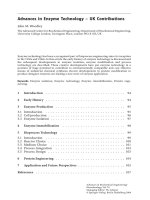advances in clinical trial biostatistics - nancy l. geller
Bạn đang xem bản rút gọn của tài liệu. Xem và tải ngay bản đầy đủ của tài liệu tại đây (2.15 MB, 278 trang )
ADVANCES
IN
CLINICAL
TRIAL
B
IOSTATISTI
CS
edited
by
NANCY
L.
GELLER
National Heart, Lung, and Blood Institute
National Institutes
of
Health
Bethesda, Maryland,
U.S.A.
MARCEL
MARCEL DEKKER,
INC.
DEKKER
NEW
YORK
-
BASEL
Copyright n 2004 by Marcel Dekker, Inc. All Rights Reserved.
This book was edited by Nancy L. Geller in her private capacity. The views expressed do not
necessarily represent the views of NIH, DHHS, or the United States.
Although great care has been taken to provide accurate and current information, neither the
author(s) nor the publisher, nor anyone else associated with this publication, shall be liable for
any loss, damage, or liability directly or indirectly caused or alleged to be caused by this book.
The material contained herein is not intended to provide specific advice or recommendations
for any specific situation.
Trademark notice: Product or corporate names may be trademarks or registered trademarks
and are used only for identification and explanation without intent to infringe.
Library of Congress Cataloging-in-Publication Data
A catalog record for this book is available from the Library of Congress.
ISBN: 0-8247-9032-4
This book is printed on acid-free paper.
Headquarters
Marcel Dekker, Inc., 270 Madison Avenue, New York, NY 10016, U.S.A.
tel: 212-696-9000; fax: 212-685-4540
Distribution and Customer Service
Marcel Dekker, Inc., Cimarron Road, Monticello, New York 12701, U.S.A.
tel: 800-228-1160; fax: 845-796-1772
Eastern Hemisphere Distribution
Marcel Dekker AG, Hutgasse 4, Postfach 812, CH-4001 Basel, Switzerland
tel: 41-61-260-6300; fax: 41-61-260-6333
World Wide Web
The publisher offers discounts on this book when ordered in bulk quantities. For more
information, write to Special Sal es/Professional Marketing at the headquarters address
above.
Copyright nnnnnnnnn 2004 by Marcel Dekker, Inc. All Rights Reserved.
Neither this book nor any part may be reproduced or transmitted in any form or by any
means, electronic or mechanical, including photocopying, microfilming, and recording, or by
any information storage and retrieval system, without permis sion in writing from the
publisher.
Current printing (last digit):
10987654321
PRINTED IN THE UNITED STATES OF AMERICA
Copyright n 2004 by Marcel Dekker, Inc. All Rights Reserved.
Biostatistics:
A
Series
of
References and Textbooks
Series Editor
Shein-Chung Chow
Vice President, Clinical Biostatistics and Data Management
Millennium Pharmaceuticals, Inc.
Cambridge, Massachusetts
Adjunct Professor
Temple University
Philadelphia, Pennsylvania
1.
Design and Analysis of Animal Studies in Pharmaceutical Devel-
opment,
edited by Shein-Chung Chow and Jen-pei Liu
2.
Basic Statistics and Pharmaceutical Statistical Applications, James
E.
De Muth
3.
Design and Analysis
of
Bioavailability and Bioequivalence Studies,
Second Edition, Revised and Expanded,
Shein-Chung Chow and
Jen-pei Liu
4. Meta-Analysis in Medicine and Health Policy, edited by Dalene K.
Stangl and Donald A. Berry
5.
Generalized Linear Models: A Bayesian Perspective, edited by Dipak
K. Dey, Sujit K. Ghosh, and Bani K. Mallick
6.
Difference Equations with Public Health Applications, Lemuel A. Moye
and Asha Seth Kapadia
7.
Medical Biostatistics, Abhaya lndrayan and Sanjeev
B.
Sarrriukaddam
8.
Statistical Methods for Clinical Trials, Mark
X.
Norleans
9.
Causal Analysis in Biomedicine and Epidemiology: Based on Minimal
Sufficient Causation,
Mike1 Aickin
10.
Statistics in Drug Research: Methodologies and Recent Develop-
ments,
Shein-Chung Chow and Jun Shao
11.
Sample Size Calculations in Clinical Research, Shein-Chung Chow,
Jun Shao, and Hansheng Wang
12.
Applied Statistical Designs for the Researcher, Daryl
S.
Paulson
13. Advances in Clinical Trial Biostatistics, Nancy L. Geller
ADDITIONAL VOLUMES IN PREPARATION
Copyright n 2004 by Marcel Dekker, Inc. All Rights Reserved.
Series Introduction
The primary objectives of the Biostatistics series are to provide useful ref-
erence books for researchers and scientists in academia, industry, and
government, and also to offer textbooks for undergraduate and/or grad-
uate courses in the area of biostatistics. The series provides comprehensive
and unified presentations of statistical designs and analyses of important
applications in biostatistics, such as those in biopharmaceuticals. A well-
balanced summary is given of current and recently developed statistical
methods and interpretations for both statisticians and researchers/scien-
tists with minimal statistical knowledge who are engaged in the field of
applied biostatistics. The series is committed to presenting easy-to-under-
stand, state-of-the-art references and textbooks. In each volume, statistical
concepts and methodologies are illustrated throu gh real-world examples
whenever possible.
Clinical research is a lengthy and costly process that involves drug
discovery, form ulation, laboratory development, animal studies, clinical
development, and regu latory submission. This lengthy process is necessary
not only for understanding the target disease but also for providing sub-
stantial evidence regarding efficacy and safety of the pharmaceutical com-
pound under investigation prior to regulatory approval. In addition, it
provides assurance that the drug products under investigation will possess
good characteristics such as identity, strength, quality, purity, and stability
after regulatory approval. For this purpose, biostatistics plays an impor-
Copyright n 2004 by Marcel Dekker, Inc. All Rights Reserved.
tant role in clinical research not only to provide a valid and fair assess-
ment of the drug product under investigation prior to regulatory approval
but also to ensure that the drug product possesses good characteristics with
the desired accuracy and reliability.
This volume provides a comprehensive summarization of recen t
developments regarding methodologies in design and analysis of studies
conducted in clinical research. It covers important topics in early-phase
clinical development such as Bayesian methods for phase I cancer clinical
trials and late-phase clinical development such as design and analysis of
therapeutic equivalence trials, adaptive two-stage clinical trials, and cluster
randomization trials. The book also provides useful approaches to critical
statistical issues that are commonly encountered in clinical research such as
multiplicity, subgroup analysis, interaction, and analysis of longitudinal
data with missing values. It will be beneficial to biostatisticians, medical
researchers, and pharmaceutical scientists who are engaged in the areas of
clinical research and development.
Shein-Chung Chow
Series Introductioniv
Copyright n 2004 by Marcel Dekker, Inc. All Rights Reserved.
Preface
As the medical sciences rapidly advance, clinical trials biostatisticians and
graduate students preparing for careers in clinical trials need to maintain
knowledge of current methodology. Because the literature is so vast and
journals are published so frequently, it is difficult to keep up with the rel-
evant literature. The goal of this book is to summ arize recent methodology
for design and analysis of clinical trials arranged in standalone chapters.
The book surveys a number of aspects of contemporary clinical trials,
ranging from early trials to complex modeling problems. Each chapter
contains enough references to allow those interested to delve more deeply
into an area. A basic knowledge of clinical trials is assumed, along with a
good background in classical biostatistics. The chapters are at the level of
journal articles in Biometrics or Statistics in Medicine and are meant to be
read by second- or third-year biostatistics graduate students, as well as by
practicing biostatisticians.
The book is arranged in three parts. The first consists of two chapters
on the first trials undertaken in humans in the course of drug development
(Phase I and II trials). The second and largest part is on randomized clinical
trials, covering a variety of design and analysis topics. These include design
of equivalence trials, adaptive schemes to c hange sample size during the
course of a trial, design of clustered randomized trials, design and analysis
of trials with multiple primary endpoints, a new method for survival analy-
sis, and how to report a Bayesian randomized trial. The third section deals
Copyright n 2004 by Marcel Dekker, Inc. All Rights Reserved.
with more complex problems: including compliance in the assessment of
treatment effects, the analysis of longitudinal data with missingness, and
the particular problems that have arisen in AIDS clinical trials. Several of
the chapters incorporate Bayesian methods, reflecting the recognition that
these have become acceptable in what used to be a frequentist discipline.
The 20 authors of this volume represent five countries and 10 insti-
tutions. Many of the authors are well known internationally for their meth-
odological contributions and have extensive experience in clinical trials
practice as well as being methodologists. Each chapter gives real and rel-
evant examples from the authors’ personal experiences, making use of a
wide range of both treatment and prevention trials. The examples reflect
work in a variety of fields of medicine, such as cardiovascular diseases, neu-
rological diseases, cancer, and AIDS. While it was often the clinical trial
itself that gave rise to a question that required new methodology to answer,
it is likely that the methods will find applications in other medical fields. In
this sense, the contributions are examples of ‘‘ ideal’’ biostatistics, tran-
scending the boundary between statistical theory and clinical trials prac-
tice.
I wish to express my deep appreciation to all the authors for their
patience and collegiality and for their fine contributions and outstanding
expositions. I also thank my husband for his constant encouragement
and Marcel Dekker, Inc., for their continuing interest in this project.
Nancy L. Geller
Prefacevi
Copyright n 2004 by Marcel Dekker, Inc. All Rights Reserved.
Contents
Series Introduction
Preface
Contributors
Part I METHODS FOR EARLY TRIALS
1. Bayesian Methods for Cancer Phase I Clinical Trials
James S. Babb and Andre
´
Rogatko
2. Design of Early Trials in Stem Cell Transplantation:
A Hybrid Frequentist-Bayesian Approach
Nancy L. Geller, Dean Follmann, Eric S. Leifer, and
Shelly L. Carter
Part II METHODS FOR RANDOMIZED TRIALS
3. Design and Analysis of Therapeutic Equivalence Trials
Richard M. Simon
4. Adaptive Two-Stage Clinical Trials
Michael A. Proschan
5. Design and Analysis of Cluster Randomization Trials
David M. Zucker
Copyright n 2004 by Marcel Dekker, Inc. All Rights Reserved.
6. Design and Analysis of Clinical Trials with Multiple
Endpoints
Nancy L. Geller
7. Subgroups and Interactions
Dean Follmann
8. A Class of Permutation Tests for Some Two-Sample
Survival Data Problems
Joanna H. Shih and Michael P. Fay
9. Bayesian Reporting of Clinical Trials
Simon Weeden, Laurence S. Freedman, and Mahesh
Parmar
Part III MORE COMPLEX PROBLEMS
10. Methods Incorporating Compliance in Treatment
Evaluation
Juni Palmgren and Els Goetghebeur
11. Analysis of Longitudinal Data with Missingness
Paul S. Albert and Margaret C. Wu
12. Statistical Issues Emerging from Clinical Trials in HIV
Infection
Abdel G. Babiker and Ann Sarah Walker
Index of Abbreviations
Index of Clinical Trials Used as Examples
Subject Index
Contentsviii
Copyright n 2004 by Marcel Dekker, Inc. All Rights Reserved.
Contributors
Paul S. Albert, Ph.D. Mathematical Statistician, Biometrics Research
Branch, Divi sion of Cancer Treatment and Diagnosis, National Cancer
Institute, National Institutes of Health, Bethesda, Maryland, U.S.A.
James S. Babb, Ph.D. Department of Biostatistics, Fox Chase Cancer
Center, Philadelphia, Pennsylvania, U.S.A.
Abdel G. Babiker, Ph.D. Head, Division of HIV and Infections, and
Professor of Medical Statistics and Epidemiology, M edical Research
Council Clinical Trials Unit, London, England
Shelly L. Carter, Sc.D. Senior Biostatistician, The Emmes Corporation,
Rockville, Maryland, U.S.A.
Michael P. Fay, Ph.D. Mathematical Statistician, Statistical Research
and Applications, National Cancer Institute, National Institutes of
Health, Bethesda, M aryland, U.S.A.
Dean Follmann, Ph.D. Chief, Biostatistics Research Branch, National
Institute of Allergy and Infectious Diseases, National Institutes of Health,
Bethesda, Maryland, U.S.A.
Copyright n 2004 by Marcel Dekker, Inc. All Rights Reserved.
Laurence S. Freedman, M.A., Dip.Stat., Ph.D. Professor, Departments
of Mathematics and Statistics, Bar-Ilan University, Ramat Gan, Israel
Nancy L. Geller, Ph.D. Director, Office of Biostatistics Research,
National Heart, Lung, and Blood Institute, National Institutes of Health,
Bethesda, Maryland, U.S.A.
Els Goetghebeur, Ph.D. Professor, Department of Applied Mathematics
and Computer Science, University of Ghent, Ghent, Belgium
Eric S. Leifer, Ph.D. Mathematical Statistician, Office of Biostatistics
Research, National Heart, Lung, and Blood Institute, National Institutes
of Health, Bethesda, Maryland, U.S.A.
Juni Palmgren, Ph.D. Professor, Department of Mathematical Statistics
and Department of Medical Epidemiology and Biostatistics, Stockholm
University and Karolinska Institutet, Stockholm, Sweden
Mahesh Parmar, D.Phil., M.Sc., B.Sc. Professor of Medical Statistics
and Epidemiology, Cancer Division, Medical Research Council Clinical
Trials Unit, London, England
Michael A. Proschan, Ph.D. Mathematical Statistician, Office of Bio-
statistical Research, National Heart, Lung, and Blood Institute, National
Institutes of Health, Bethesda, Maryland, U.S.A.
Andre
´
Rogatko, Ph.D. Department of Biostatistics, Fox Chase Cancer
Center, Philadelphia, Pennsylvania, U.S.A.
Joanna H. Shih, Ph.D. Mathematical Statistician, Biometric Research
Branch, Divisi on of Cancer Treatment and Diagnosis, National Cancer
Institute, National Institutes of Health, Bethesda, Maryland, U.S.A.
Richard M. Simon, D.Sc. Chief, Biometric Research Branch, Division of
Cancer Treatment and Diagnosis, National Cancer Institute, National
Institutes of Health, Bethesda, Maryland, U.S.A.
Ann Sarah Walker, Ph.D., M.Sc. Medical Research Council Clinical
Trials Unit, London, England
Contributorsx
Copyright n 2004 by Marcel Dekker, Inc. All Rights Reserved.
Simon Weeden, M.Sc. Senior Medical Stat istician, Cancer Division,
Medical Research Council Clinical Trials Unit, London, England
Margaret C. Wu, Ph.D.* Mathematical Statistician, Office of Biostatis-
tics Research, National Heart, Lung, and Blood Institute, National Insti-
tutes of Health, Bethesda, Maryland, U.S.A.
David M. Zucke r, Ph.D. Associate Professor, Department of Statistics,
Hebrew University, Jerusalem, Israel
*
Retired.
Contributors xi
Copyright n 2004 by Marcel Dekker, Inc. All Rights Reserved.
1
Bayesian Methods for Cancer
Phase I Clinical Trials
James S. Babb and Andre
´
Rogatko
Fox Chase Cancer Center, Philadelphia, Pennsylvania, U.S.A.
1. INTRODUCTION
1.1. Goal and Definitions
The primary statistical objective of a cancer phase I clinical trial is to
determine the optimal dose of a new treatment for subsequent clinical
evaluation of efficacy. The dose sought is typically referred to as the
maximum tolerated dose (MTD), and its definition depends on the
severity and manageability of treatment side effects as well as on clinical
attributes of the target patient population. For most anticancer regimens,
evidence of treatment benefit, usually expressed as a reduction in tumor
size or an increase in survival, requires months (if not years) of obser-
vation and is therefore unlikely to occur during the relatively short time
course of a phase I trial (O’Quigley et al., 1990; Whitehead, 1997).
Consequently, the phase I target dose is usually defined in terms of the
prevalence of treatment side effects without direct regard for treatment
efficacy. For the majority of cytotoxic agents, toxicity is considered a
prerequisite for optimal antitumor activity (Wooley and Schein, 1979)
and the probability of treatment benefit is assumed to monotonically
increase with dose, at least over the range of doses under considera tion in
the phase I trial. Consequently, the MTD of a cytoto xic agent typically
corresponds to the highest dose associated with a tolerable level of
Copyright n 2004 by Marcel Dekker, Inc. All Rights Reserved.
toxicity. More precisely, the MTD is defined as the dose expected to
produce some degree of medically unacceptable, dose limiting toxicity
(DLT) in a specified proportion u of patients (Storer, 1989; Gatsonis and
Greenhouse, 1992). Hence we have
ProbfDLT j Dose ¼ MTDg¼u ð1Þ
where the value chosen for the target probability u would depend on the
nature of the dose limiting toxicity; it would be set relatively high when the
DLT is a transient, correctable, or nonfatal condition, and low when it is
lethal or life threatening (O’Quigley et al., 1990). Participants in cancer
phase I trials are usually late stage patients for whom most or all alternative
therapies have failed. For such patients, toxicity may be severe before it is
considered an intolerable burden (Whitehead, 1997). Thus, in cancer phase
I trials, dose limiting toxicity is often severe or potentially life threatening
and the target probability of toxic response is correspondingly low,
generally less than or equal to 1/3. As an example, in a phase I trial
evaluating 5-fluor ouracil (5-FU) in combination with leucovorin and
topotecan (see Sec. 1.4.1), dose limiting toxicity was defined as any treat-
ment attributable occurrence of: (1) a nonhematologic toxicity (e.g.,
neurotoxicity) whose severi ty according to the Common Toxicity Criteria
*
of the National Cancer Institute (1993) is grade 3 or higher; (2) a grade 4
hematologic toxicity (e.g., thrombocytopenia or myelosuppression) per-
sisting at least 7 days; or (3) a 1 week or longer interruption of the treatment
schedule. The MTD was then defined as the dose of 5-FU that is expected
to induce such dose limiting toxicity in one-third of the patients in the
target population. As illustrated with this example, the definition of DLT
should be broad enough to capture all anticipated forms of toxic response
as well as many that are not necessarily anticipated, but may nonetheless
occur. This will reduce the likelihood that the definition of DLT will need
to be altered or clarified upon observation of unanticipated, treatment-
attributable adverse events—a process generally requiring a formal
amendment to the trial protocol and concomitant inter ruption of patient
accrual and treatment.
It is important to note that there is currently no consensus regard-
ing the definition of the MTD. When the phase I trial is designed
*
The Common Toxicity Criteria can be found on the Internet at />CTC3/default.htm.
Babb and Rogatko2
Copyright n 2004 by Marcel Dekker, Inc. All Rights Reserved.
according to traditional, non-Bayesian methods (e.g., the up-and-down
schemes described in Storer, 1989), an empiric, data-based definition is
most often employed. Thus, the MTD is frequently taken to be the high-
est dose utilized in the trial such that the percentage of patients
manifesting DLT is equal to a specified level such as 33%. For example,
patients are often treated in cohorts, usually consisting of three patients,
with all patients in a cohort receiving the same dose. The dose is changed
between successive cohorts according to a predetermined schedule typi-
cally based on a so-called modified Fibonacci sequence (Von Hoff et al.,
1984). The trial is terminat ed the first time at least some number of
patients (generally 2 out of 6) treated at the same dose exhibit DLT. This
dose level constitutes the MTD. The dose level recommended for phase II
evaluation of efficacy is then taken to be either the MTD or one dose level
below the MTD (Kramar et al., 1999). Although this serves as an
adequate working definition of the MTD for trials of nonparametric
design, such an empiric formulation is not appropriate for use with most
Bayesian and other parametric phase I trial design methodologies.
Consequently, it will be assumed throughout the remaind er of this chap-
ter that the MTD is defined according to Eq. (1) for some suitable defi-
nition of DLT and choice of target probability u.
The fundamental conflict underlying the design of cancer phase I
clinical trials is that the desire to increase the dose slowly to avoid
unacceptable toxic events must be tempered by an acknowledgment that
escalation proceeding too slowly may cause many patients to be treated
at suboptimal or nontherapeutic doses (O’Quigley et al., 1990). Thus,
from a therapeutic perspective, one should design cancer Phase I trials to
minimize both the number of patients treated at low, nontherapeutic
doses as well as the number given severely toxic overdoses.
1.2. Definition of Dose
Bayesian procedures for designing phase I clinical trials require the
specification of a model for the relationship between dose level and
treatment related toxic response. Depending on the agent under inves-
tigation and the route and schedule of its administration, the model may
relate toxicity to the physical amount of agent given each patient, or to
some target drug exposure such as the area under the time vs. plasma
concentration curve (AUC) or peak plasma concentration. The choice of
formulation is dependent on previous experience and medical theory and
is beyond the scope of the present chapter. Consequently, it will be
Bayesian Methods for Cancer Phase I Clinical Trials 3
Copyright n 2004 by Marcel Dekker, Inc. All Rights Reserved.
assumed that the appropriate representation of dose level has been de-
termined prior to specification of the dose-toxicity model.
1.3. Choice of Starting Dose
In cancer therapy, the phase I trial often represents the first time a
particular treatment regimen is being administered to humans. Due to
consequent safety considerations, the starting dose in a cancer phase I
trial is traditionally a low dose at which no significant toxicity is
anticipated. For example, the initial dose is frequently selected on the
basis of preclinical investigation to be one-tenth of the murine equivalent
LD
10
(the dose that produces 10% mortality in mice ) or one-third the
toxic dose low (first toxic dose) in dogs (Geller, 1984; Penta et al., 1992).
Conversely, several authors (e.g., O’Quigley et al., 1990) suggest that the
starting dose should correspond to the experimenter’s best prior estimate
of the MTD, which may not be a conservative initial level. This may be
appropriate since starting the trial at a dose level significantly below the
MTD may unduly increase the time and number of patients required to
complete the trial and since retrospective studies (Penta et al., 1992;
Arbuck, 1996) suggest that the traditional choice of starting dose often
results in numerous patients being treated at biologically inactive dose
levels. In the sequel, it will be assumed that the starting dose is pre-
determined; its choice based solely on information available prior to the
onset of the trial.
1.4. Examples
Selected aspects of the Bayesian approach to phase I trial design will be
illustrated using examples based on two pha se I clinical trials conducted
at the Fox Chase Cancer Center.
5-FU Trial
In this trial a total of 12 patients with malignant solid tumors were
treated with a combination of 5-fluorouracil (5-FU), leucovorin, and
topotecan. The goal was to determine the MTD of 5-FU, defined as the
dose that, when administered in combination with 20 mg/m
2
leucovorin
and 0.5 mg/m
2
topotecan, results in a probability u = 1/3 that a DLT will
be manifest within 2 weeks. The relevant data obtained from this trial are
given in Table 1.
Babb and Rogatko4
Copyright n 2004 by Marcel Dekker, Inc. All Rights Reserved.
PNU Trial
The incorporation of patient-specific covariate information into a Baye-
sian design scheme will be exemplified through a phase I study of PNU-
214565 (PNU) involving patients with advanced adenocarcinomas of
gastrointestinal origin (Babb and Rogatko, 2001). Previous clinical and
preclinical studies demonstrated that the action of PNU is moderated by
the neutralizing capacity of anti-SEA antibodies. Based on this, the MTD
of PNU was defined as a function of the pretreatment concentration of
circulating anti-SEA antibodies. Specifically, the MTD was defined as the
dose level expected to induce DLT in a proportion u = .1 of the patients
with a given pretreatment anti-SEA concentration.
2. GENERAL BAYESIAN METHODOLOGY
The design and conduct of phase I clinical trials would benefit from
statistical methods that can incorporate information from preclinical
studies and sources outside the trial. Furthermore, both the investigator
Table 1 Dose Level of 5-FU (mg/m
2
) and Binary
Assessment of Treatment-Induced Toxic Response
for the 12 Patients in the 5-FU Phase I Trial
Patient
a
5-FU Dose Response
1 140 No DLT
2 210 No DLT
3 250 No DLT
4 273 No DLT
5 291 No DLT
6 306 No DLT
7 318 No DLT
8 328 No DLT
9 337 No DLT
10 345 No DLT
11 352 DLT
12 338 DLT
a
Patients are listed in chronological order according to date
of accrual.
Bayesian Methods for Cancer Phase I Clinical Trials 5
Copyright n 2004 by Marcel Dekker, Inc. All Rights Reserved.
and patient might benefit if updated assessments of the risk of toxicity
were available during the trial. Both of these needs can be addressed
within a Bayesian framework. In Sections 2.1 through 2.5 we present a
description of selected Bayesian procedures developed for the specific
case where toxicity is assessed on a binary scale (presence or absence of
DLT), only a single agent is under investigation (the levels of any other
agents being fixed) and no relevant pretreatment covariate information
is available to tailor the dosing scheme to individual patient needs.
We discuss extensions and modifications of the selected methods in
Section 3.
2.1. Formulation of the Problem
Dose level will be represented by the random variable X whose realization
is denoted by x. For notational compactness, the same variable will be
used for any formulation of dosage deemed appropriate. Th us, for
example, X may represent some target drug exposure (e.g., AUC), the
physical amount of agent in appropriat e units (e.g., mg/m
2
), or the
amount of agent expressed as a multiple of the starting dose, and might
be expressed on a logarithmic or other suitable scale. It will be assumed
throughout that the MTD is expressed in a manner consistent with X.
The data observed for k patients will be denoted D
k
={(x
i
, y
i
); i =
1, , k}, where x
i
is the dose administered patient i, and y
i
is an indicator
for dose limiting toxicity assuming the value y
i
= 1 if the ith patient
manifests DLT and the value y
i
= 0, otherwise. The MTD is denoted by
g and corresp onds to the dose level expecte d to induce dose limiting
toxicity in a proportion u of patients.
In the ensuing sections, a general Bayesian paradigm for the design
of cancer phase I trials will be described in terms of three components:
1. A model for the dose-toxicity relationship. The model specifies
the probability of dose limiting toxicity at each dose level as a
function of one or more unknown parameters.
2. A prior distribution for the vector N containing the unknown
parameters of the dose-toxicity model. The prior will be
represented by a probability density function h defined on the
parametric space Q specified for N. It is chosen so that HðIÞ¼
m
I
hðuÞdu is an assessment of the probability that N is contained
in I p Q based solely on the information available prior to the
onset of the phase I trial.
Babb and Rogatko6
Copyright n 2004 by Marcel Dekker, Inc. All Rights Reserved.
3. A loss function quantifying the total cost associated with the
administration of any permissible dose level. The loss will be
expressed through a function L defined on S
Â
Q, where S is
the set of dose levels available for use in the trial. Hence, L(x, N)
denotes the loss incurred by treating a patient at dose level x 2S
when N 2 Q obtains.
Through an application of Bayes’ theorem the dose-toxicity model
and prior distribution can be used to derive the posterior distribution of N
given D
k
. Hence, we obtain a function C
k
defined on the parametric space
Q such that m
I
C
k
ðuÞdu is the conditional probability that N is contained
in I p Q given the data available after k patients have been observed. We
can then compute
EL
k
ðxÞ¼
Z
H
Lðx; uÞC
k
ðuÞdu
representing the posterior expected loss associated with dose x 2 S after
observation of k patients. When a phase I trial is designed according to
strict Bayesian decision-theoretic principles, dose escalation proceeds by
selecting for each patient the dose level x 2 S minimizing the posterior
expected loss given the prevailing data. Thus, after the responses of k
patients have been observed, the next patient (or cohort of patients)
would be administered the dose x
k+1
satisfying
EL
k
ðx
kþ1
Þ¼minfEL
k
ðxÞ:x 2 Sg
or, equivalently,
x
kþ1
¼ arg min
x S
fEL
k
ðxÞg:
As an alternative, several authors (e.g., O’Quigley et al., 1990; Gasparini
and Eisele, 2000) consider Bayesian designs wherein dose levels are
chosen to minimize L(x, ˆN
k
), where ˆN
k
is an estimate of ˆN based on the
data available after k patients have been observed. Typically, ˆN
k
corre-
sponds to the mean, median or mode of the posterior distribut ion C
k
.
The vast majority of cancer phase I clinical trial designs are
sequential in nature. That is, subsequent to one or more patients being
treated at a prespecified initial dose, dose levels are selected one at a time
on the basis of the data available from all previously treated patients.
However, nonsequential designs (e.g., Tsutakawa, 1972, 1975; Flournoy,
1993) have also been proposed wherein the design vector x, representing
Bayesian Methods for Cancer Phase I Clinical Trials 7
Copyright n 2004 by Marcel Dekker, Inc. All Rights Reserved.
the entire collection of dose levels to be used in the trial, is chosen prior to
the onset of the trial. In such circumstances, x is chosen to minimize the
expected loss with respect to the prior distribution h and patients (or
cohorts of patients) are then randomly assigned to the dose levels so
obtained. In the ensuing formulations only sequential designs will be
explicitly discussed. In other words, we consider designs that select doses
on the basis of the information conveyed by the posterior dist ribution C
k
rather than the prior distribution h.
2.2. Dose-Toxicity Model
A mathematical model is specified for the relationship between dose level
and the probability of dose limiting toxicity. The choice of model is based
on previous experience with the treatment regimen unde r investigation,
preclinical toxicology studies, medical theory, and computational trac-
tability. We note that the dose to be administer ed to the first patient or
cohort of patients is typically chosen on the basis of prior information
alone. Thus, its selection does not in general depend on the model for the
dose-toxicity relationship . Consequently, it may be advant ageous to
delay the specification of the model until after a pharmacologic and
statistical evaluation of the data from the cohort of patients treated at the
preselected starting dose.
The models most frequently used in cancer phase I clinical trials are
of the form
ProbfDLTjDose ¼xg¼Fðh
0
þ h
1
xÞ
y
ð2Þ
where F is a cumulative distribution function (CDF) referred to as the
tolerance distribution, y and h
1
are both assumed to be positive so that
the probability of dose limiting toxicity is a strictly increasing function of
dose, and one or more of y, h
0
and h
1
may be assumed known. Most
applications based on this formulation use either a logit or probit model
with typical examples including the two-parameter logistic (Gatsonis and
Greenhouse, 1992; Babb et al., 1998)
ProbfDLTjDose ¼ xg¼
expðh
0
þ h
1
xÞ
1 þexpðh
0
þ h
1
xÞ
ð3Þ
(with y = 1 assumed known) and the one-parameter hyperbolic tangent
(O’Quigley et al., 1990).
Babb and Rogatko8
Copyright n 2004 by Marcel Dekker, Inc. All Rights Reserved.
ProbfDLTjDose ¼ xg¼
tanhðxÞþ1
2
!
y
: ð4Þ
To facilitate comparisons between these two models, the hyperbolic
tangent model can be rewritten as
Prob DLT jDose ¼ x
fg
¼
expð2xÞ
1 þexpð2xÞ
!
y
which is consistent with the form given in Eq. (2) with h
0
= 0 and h
1
=2
assumed known. For exposition we consider the two-parameter logistic
model given in (3). With this model the MTD is
g ¼
lnðuÞÀlnð1 ÀuÞÀh
0
h
1
:
An illustration of the model is shown in Figure 1 and properties of the
model are given in (Johnson et al., 1995).
Figure 1 Example of the logistic tolerance distribution used as a model for the
dose-toxicity relationship. In this representation dosage has been standardized so
that the range of permissible doses is contained in the unit interval (i.e., S = [0, 1]).
For illustration, the starting dose is taken to be x
1
= 0.1 and the probability of DLT
at x
1
is denoted by U
0
. The MTD has arbitrarily been defined as the (standardized)
dose for which the probability of dose limiting toxicity is equal to u = 0.5.
Bayesian Methods for Cancer Phase I Clinical Trials 9
Copyright n 2004 by Marcel Dekker, Inc. All Rights Reserved.
An alternative formulation describes the dose-toxicity relationsh ip as
it applies to the set S={x
1
, x
2
, , x
k
} of prespecified dose levels avail able
for use in the trial. For example, Gasparini and Eisele (2000) present a
curve-free Bayesian phase I design discussed the possibility of using one
prior distribution (the design prior) to determine dose assignments during
the phase I trial and a separate prior (the inference prior) to estimate the
MTD upon trial completion. Although the use of separate priors for design
and inferenc e may appear inconsistent, its usefulness is defended by
arguing that analysis occu rs later than design (Tsutakawa, 1972). Con-
sequently, our beliefs regarding the unknown parameters of the dose-
toxicity model may change during the time from design to inference in ways
not entirely accounted for by a sequential application of Bayes’ theorem.
Since estimation of the MTD is the primary statistical aim of a
phase I clinical trial, our subsequent attention will be focused on dose-
toxicity models parameterized in terms of N =[g N] for some choice of
(possibly null) vector N of nuisance parameters. To facilitate elicitation of
prior information, the nuisance vector N should consist of parameters
that the investigators can readily interpret.
As discussed above, the starting dose of a phase I trial is frequently
selected on the basis of preclinical investigation. Consequently, prior
information is often available about the risk of toxicity at the initial dose.
To exploit this, Gatsonis and Greenhouse (1992) and Babb et al., (1998)
considered the logistic model given by (3) parameterized in terms of the
MTD
g ¼
lnðuÞÀlnð1 ÀuÞÀh
0
h
1
and
U
0
¼
expðh
0
þ h
1
x
1
Þ
1 þexpðh
0
þ h
1
x
1
Þ
the probability of DLT at the starting dose. Due to safety considerations,
the dose for the first patient (or patient cohort) is typically chosen so that
it is believed a priori to be safe for use with humans. Consequently, it is
generally assumed that U
0
V u. This information about the initial dose
can be expressed through a marginal prior distribution for U
0
whose mass
is concentrated on [0, u]. Examples include the truncated beta (Gatsonis
and Greenhouse, 1992) and uniform distributions (Babb et al., 1998)
defined on the interval (0, a) for some known value a V u. Prior in-
Babb and Rogatko10
Copyright n 2004 by Marcel Dekker, Inc. All Rights Reserved.
formation about the MTD is frequently more ambiguous. Such prior
ignorance can be reflected through the use of vague or non-informative
priors. Thus, for example, the marginal prior distribution of the MTD
might scheme in which the toxicity probabilities are modeled directly as
an unknown k-dimensional parameter vector. That is, the dose-toxicity
model is given by
Prob DLTjDose ¼ x
i
fg
¼ u
i
i ¼ 1; 2 ; ; k ð5Þ
with N =[u
1
u
2
, u
k
] unknown. The authors maintain that by
removing the assumption that the dose-toxicity relationship follows a
specific parametric curve, such as the logistic model in (3), this model
permits a more efficient use of prior information. A similar approach is
based on what has variously been referred to as an empiric discrete model
(Chevret, 1993), a power function (Kramar et al., 1999; Gasparini and
Eisele, 2000) or a power model (Heyd and Carlin, 1999). The model is
given by
Prob DLTjDose ¼ x
i
fg
¼
ˆ
u
y
i
ð6Þ
where y>0 is unknown and
ˆ
u
i
(i=1, 2, , k) is an estimate of the
probability of DLT at dose level x
i
based solely on information
available prior to the onset of the phase I trial. With this model the
toxicity probabilities can be increased or decreased through the param-
eter N = y as accumulating data suggests that the regimen is more or
less toxic than was suggested by prior opinion. As noted by Gasparini
and Eisele (2000), the empiric discrete model of Eq. (6) is equivalent to
the hyperbolic tangent model of Eq. (4) provided one uses as prior
estimates
ˆ
u
i
¼
tanhðx
i
Þþ1
2
i ¼ 1; 2 ; ; k :
2.3. Prior Distribution
The Bayesian formulation requires the specification of a prior probability
distribution for the vector v containing the unknown parameters of the
dose-toxicity model. The prior distribution is su bjective; i.e., it conveys
Bayesian Methods for Cancer Phase I Clinical Trials 11
Copyright n 2004 by Marcel Dekker, Inc. All Rights Reserved.
the opinions of the investigators prior to the onset of the trial. It is
through the prior that information from previous trials, clinical and
preclinical experience, and medical theory are incorporated into the
analysis. The prior distribution should be concentrated in some mean-
ingful way around a prior guess ˆN
0
(provided by the clinicians), yet it
should also be sufficiently diffuse as to allow for dose escalation in the
absence of dose limiting toxicity (Gasparini and Eisele, 2000). We note
that several authors (e.g., Tsutakawa, 1972, 1975) have be taken to be a
uniform distribution on a suitably defined interval (Babb et al., 1998) or a
normal distribution with appropriately large variance (Gatsonis and
Greenhouse, 1992).
Example: 5-FU Trial (continued)
The statistical goal of the trial was to determine the MTD of 5-FU
when administered in conjunction with 20 mg/m
2
leucovorin and 0.5 mg/
m
2
topotecan. The dose-toxici ty model used to design the trial was that
given by Eq. (3), reparameterized in terms of r =[g U
0
]. Preliminary
studies indicated that 140 mg/m
2
of 5-FU was well tolerated when given
concurrently with up to 0.5 mg/m
2
topotecan. Consequently, this level
was selected as the starting dose for the trial and was believed a priori
to be less than the MTD. Furthermore, previous trials involving 5-FU
alone estimated the MTD of 5-FU as a single agent to be 425 mg/m
2
.
Since 5-FU has been observed to be more toxic when in combination
with topotecan than when administered alone, the MTD of 5-FU in
combination with leucovorin and topotecan was assumed to be less
than 425 mg/m
2
. Overall, previous experience with 5-FU led to the
assumption that g 2 [140, 425] and U
0
< 1/3 with prior probability one.
Based on this, the joint prior probability density function of N was
taken to be
hðNÞ¼57
À1
I
Q
ðg; U
0
Þ Q ¼½140; 425½0; 0:2ð7Þ
where, for example, I
S
denotes the indicator function for the set S [i.e.,
I
S
(x) = 1 or 0 according as x does or does not belong to S ]. It follows
from (7) that the MTD and U
0
were assumed to be independently and
marginally distributed as uniform random variables. In the example
above, there was a suitable ch oice for an upper bound on the range of
dose levels to be searched for the MTD. That is, prior experience with
Babb and Rogatko12
Copyright n 2004 by Marcel Dekker, Inc. All Rights Reserved.
5-FU suggested that, when given in combination with topotecan, the
MTD of 5-FU was a priori believed to be less than 425 mg/m
2
.In
consequence, the support of the prior for the MTD was finite. In many
contexts, there will not be sufficient information available prior to the
onset of the phase I tri al to unambiguously determine a suitable upper
bound for the MTD (and hence for the range of dose levels to be
searched). In this case, one might introduce a hyperparameter X
max
and
specify a joint prior distribution for the MTD and X
max
as
hðg; X
max
Þ¼f
1
ðg j X
max
Þf
0
ðX
max
Þ
with, to continue the 5-FU example, f
1
(gjX
max
) denoting the probability
density function (pdf) of a uniform random variable on [140, 425] and
f
0
(X
max
) a monotone decreasing pdf defined on [425, l), such as a
truncated normal with mean 425 and suitable standard deviation.
Flournoy (1993) considered the two-paramete r logistic model in Eq.
(3) reparameterized in terms of the MTD and the nuisance parameter
N = h
2
. The parameters g and N were assumed to be independent a priori
with g having a normal and N having a gamma distribution. Thus, the
joint prior distribution of v =[g h
2
] was defined on Q = R
Â
(0,
l
)
by
hðnÞ¼½GðaÞb
a
j
ffiffiffiffiffiffi
2k
p
À1
h
2ðaÀ1Þ
exp
Àðg ÀAÞ
2
2j
2
À
h
2
b
:
As rationale for the choice of prior distribution for N, it was noted that
N
À1
is proportional to the variance of the logistic tolerance distribution
and that the gamma distribution is frequently used to model the inverse
of a variance component. In order to determine values for the hyper-
parameters a, b, A,andj, physicians were asked to graph curves
corresponding to a prior 95% confidence band for the true dose-toxicity
relationship. Values were then chosen for the hyperparameters so that the
95% confidence intervals at selected doses, as determined by the upper
and lower hand drawn graphs at each dose, agreed with the correspond-
ing confidence intervals implied by the prior.
Various authors (e.g., Chevret, 1993; Faries, 1994; Moller, 1995;
Goodman et al., 1995) studying the continual reassessment method
(O’Quigley et al., 1990) have considered monoparametric dose-toxicity
models such as the hyperbolic tangent model of Eq. (4) and the empiric
Bayesian Methods for Cancer Phase I Clinical Trials 13
Copyright n 2004 by Marcel Dekker, Inc. All Rights Reserved.









